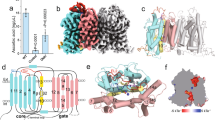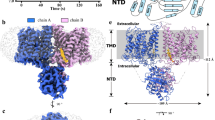Abstract
ALTHOUGH vitamin C is critical to human physiology1–5, it is not clear how it is taken up into cells. The kinetics of cell and tissue accumulation of ascorbic acid in vitro indicate that the process is mediated by specific transporters at the cell membrane6. Some experimental observations have linked the transport of ascorbic acid with hexose transport systems in mammalian cells, although no clear information is available regarding the specific role(s) of these transporters, if any, in this process7–16. Here we use the Xenopus laevis oocyte expression system to show that the mammalian facilitative hexose transporters are efficient transporters of the oxidized form of vitamin C (dehydroascorbic acid). Two transport pathways, one with low affinity and one with high affinity for dehydroascorbic acid, were found in oocytes expressing the mammalian transporters, and these oocytes accumulated vitamin C against a concentration gradient when supplied with dehydroascorbic acid. We obtained similar results in experiments using normal human neutrophils. These observations indicate that mammalian facilitative hexose transporters are a physiologically significant pathway for the uptake and accumulation of vitamin C by cells, and suggest a mechanism for the accumulation of ascorbic acid against a concentration gradient.
This is a preview of subscription content, access via your institution
Access options
Subscribe to this journal
Receive 51 print issues and online access
$199.00 per year
only $3.90 per issue
Buy this article
- Purchase on Springer Link
- Instant access to full article PDF
Prices may be subject to local taxes which are calculated during checkout
Similar content being viewed by others
References
Crandon, J. H. & Lund, C. C. New Engl. J. Med. 223, 353–369 (1940).
Hodges, R. E. Baker, E. M., Hood, J. H., Sauberlich, H. E. & Baker, E. M. Am. J. clin. Nutr. 22, 535–548 (1969).
Hodges, R. E., Baker, E. M., Hod, J. H., Sauberlich, H. E. & Baker, E. M. Am. J. clin. Nutr. 24, 432–443 (1971).
Englard, S. & Steifter, S. A. Rev. Nutr. 6, 365–406 (1986).
Padh, H. Biochem. Cell Biol. 68, 1166–1173 (1990).
Rose, R. C. Biochim. biophys. Acta 947, 335–366 (1988).
Siliprandi, L., Vanni, P., Kessler, M. & Semenza, G. Biochim. biophys. Acta 552, 129–142 (1979).
Toggenburger, G. et al. Biochim. biophys. Acta 646, 433–443 (1981).
Bigley, R., Wirth, M., Layman, D., Riddle, M. & Stankova, L. Diabetes 32, 545–548 (1983).
Bianchi, J., Wilson, F. A. & Rose, R. C. Am. J. Physiol. 250, G461–G468 (1986).
Ingermann, R. L., Stankova, L. & Bigley, R. H. Am. J. Physiol. 250, C637–C641 (1986).
Rose, R. C. Am. J. Physiol. 250, F627–F632 (1986).
Padh, H. & Aleo, J. J. Biochim. biophys. Acta 901, 283–290 (1987).
McLennan, S. et al. Diabetes 37, 359–361 (1988).
Wilson, J. X. & Dixon, J. S. J. Membr. Biol. 111, 83–91 (1989).
Waskho, P. & Levine, M. J. biol. Chem. 267, 23568–23574 (1992).
Winkler, B. S. Biochim. biophys. Acta 925, 258–264 (1987).
Wunderling, M., Paul, H.-H. & Lohmann, W. Biol. Chem. Hoppe-Seyler 367, 1047–1054 (1986)
Birnbaum, M., Haspel, H. & Rosen, O. Proc. natn. Acad. Sci. U.S.A. 83, 5784–5788 (1986).
Vera, J. C. & Rosen, O. Molec. cell. Biol. 9, 4187–4195 (1989).
Vera, J. C. & Rosen, O. Molec. cell. Biol. 10, 743–751 (1990).
Oka, Y. et al. Nature 345, 550–553 (1990).
Jung, C. Y. & Rampal, A. L. J. biol. Chem. 252, 5456–5463 (1977).
Wheeler, T. J. & Hinkle, P. C. A. Rev. Biochem. 47, 503–517 (1985).
Thorens, B., Sarkar, H., Kaback, H. & Lodish, H. Cell 55, 281–290 (1988).
Washko, P., Rotrosen, D. & Levine, M. J. biol. Chem. 264, 18996–19002 (1989).
Dhariwal, K. R., Hartzell, W. O. & Levine, M. Am. J. clin. Nutr. 54, 712–716 (1991).
Moser, U. & Weber, F. Int. J. Vit. Nutr. Res. 54, 47–53 (1984).
Bergsten, P. et al. J. biol. Chem. 265, 2584–2587 (1990).
Bigley, R. H. & Stankova, L. J. exp. Med. 139, 1084–1092 (1974).
Raghoebar, M., Huisman, J. A. M., van den Berg, W. B. & van Ginnekan, C. A. M. Life Sci. 40, 499–510 (1987).
Author information
Authors and Affiliations
Rights and permissions
About this article
Cite this article
Vera, J., Rivas, C., Fischbarg, J. et al. Mammalian facilitative hexose transporters mediate the transport of dehydroascorbic acid. Nature 364, 79–82 (1993). https://doi.org/10.1038/364079a0
Received:
Accepted:
Issue Date:
DOI: https://doi.org/10.1038/364079a0
This article is cited by
-
Tumor Microenvironment Biosensors for Hyperpolarized Carbon-13 Magnetic Resonance Spectroscopy
Molecular Imaging and Biology (2021)
-
High-Dose Intravenous Ascorbic Acid: Ready for Prime Time in Traumatic Brain Injury?
Neurocritical Care (2020)
-
Erythroid glucose transport in health and disease
Pflügers Archiv - European Journal of Physiology (2020)
-
The Xc− inhibitor sulfasalazine improves the anti-cancer effect of pharmacological vitamin C in prostate cancer cells via a glutathione-dependent mechanism
Cellular Oncology (2020)
-
Structure, function and regulation of mammalian glucose transporters of the SLC2 family
Pflügers Archiv - European Journal of Physiology (2020)
Comments
By submitting a comment you agree to abide by our Terms and Community Guidelines. If you find something abusive or that does not comply with our terms or guidelines please flag it as inappropriate.



